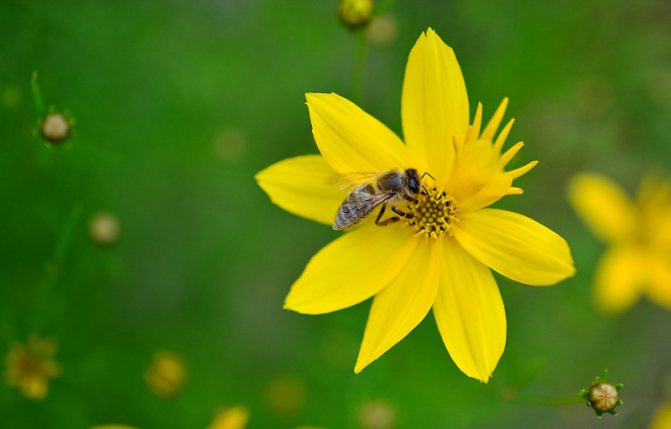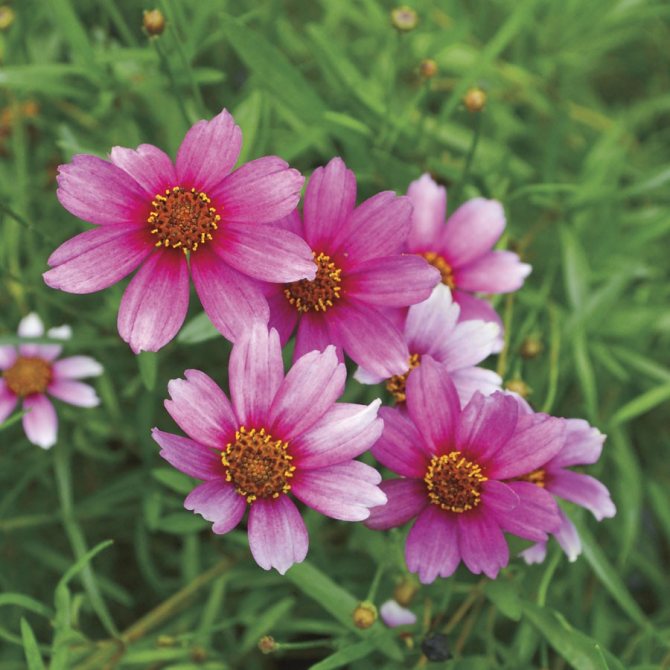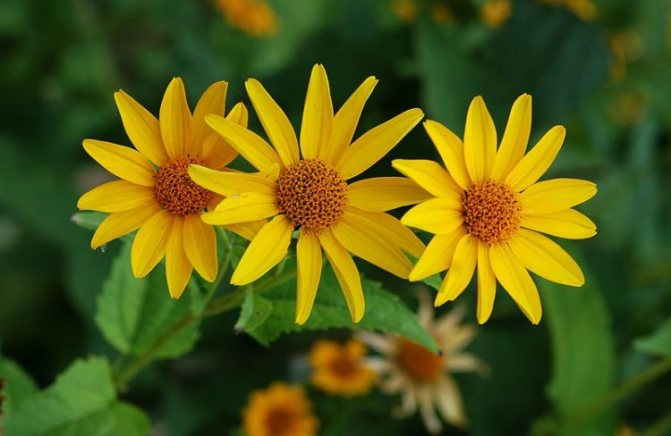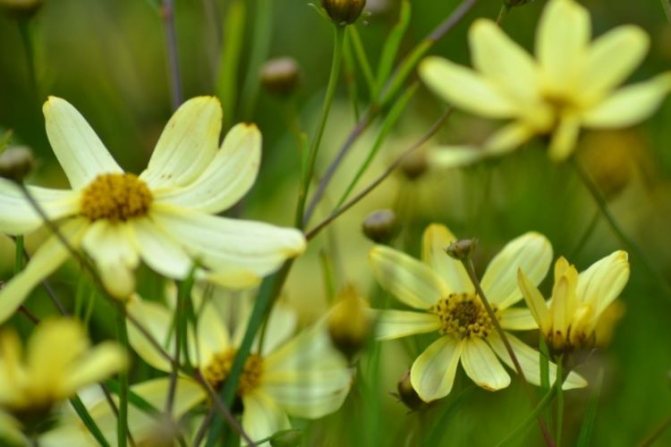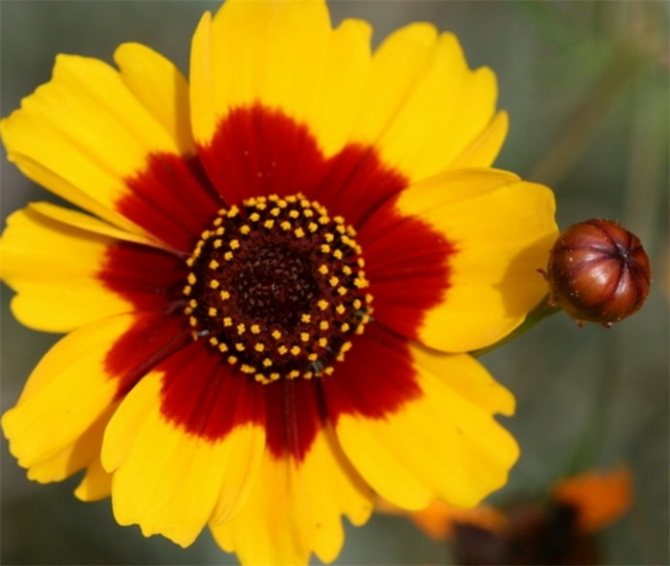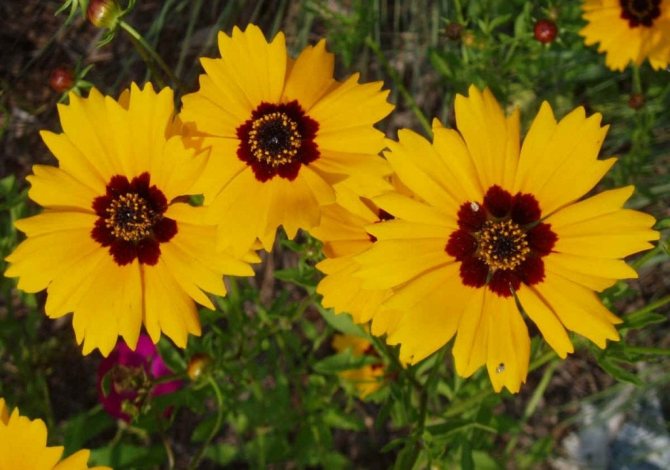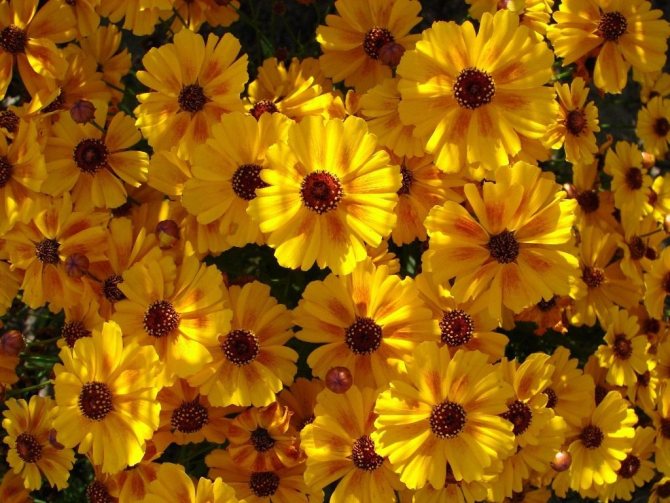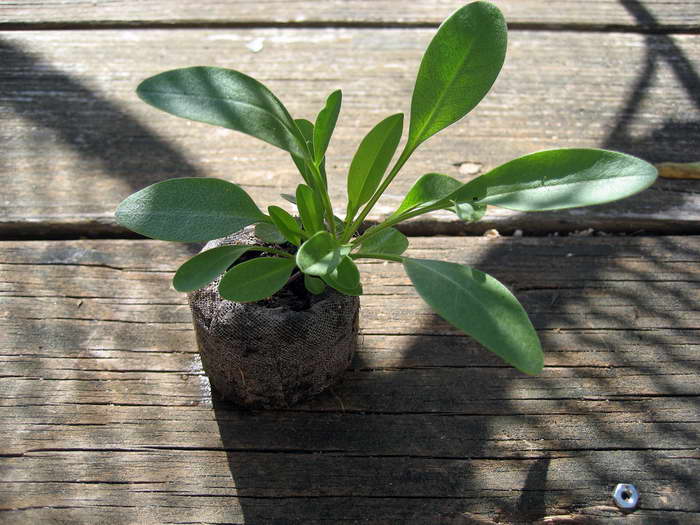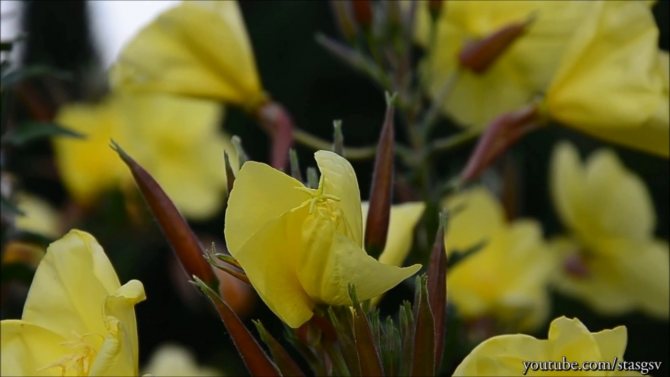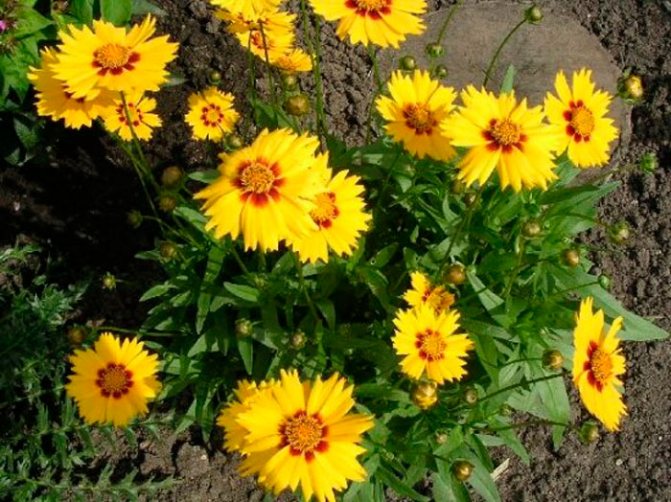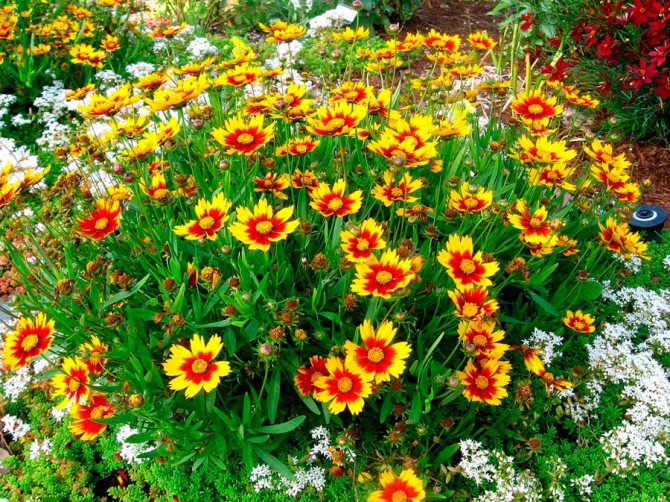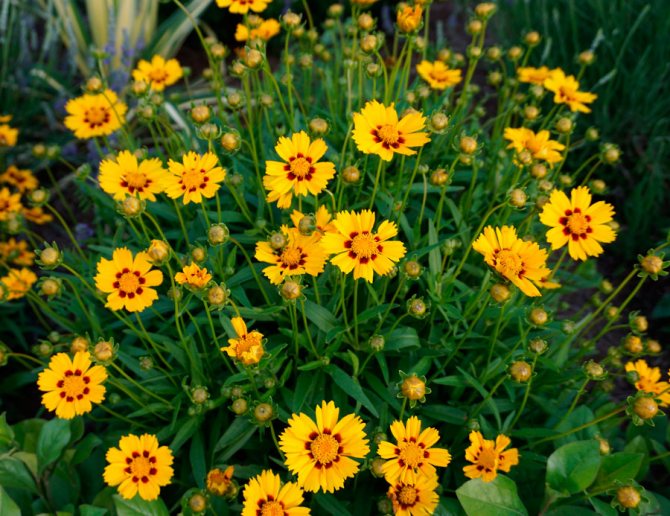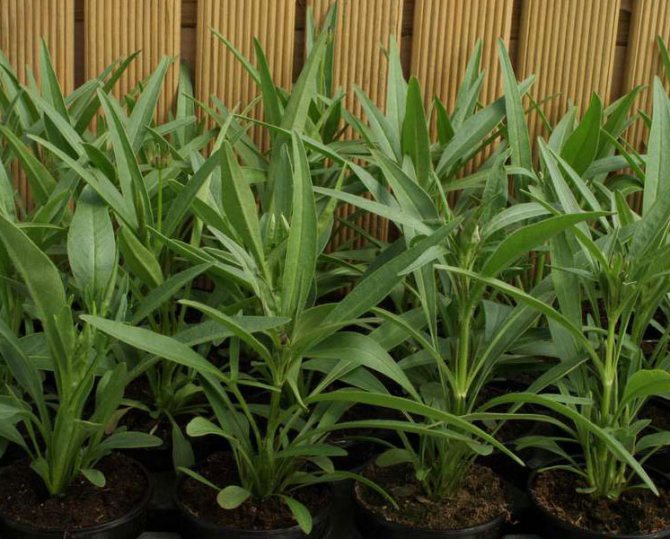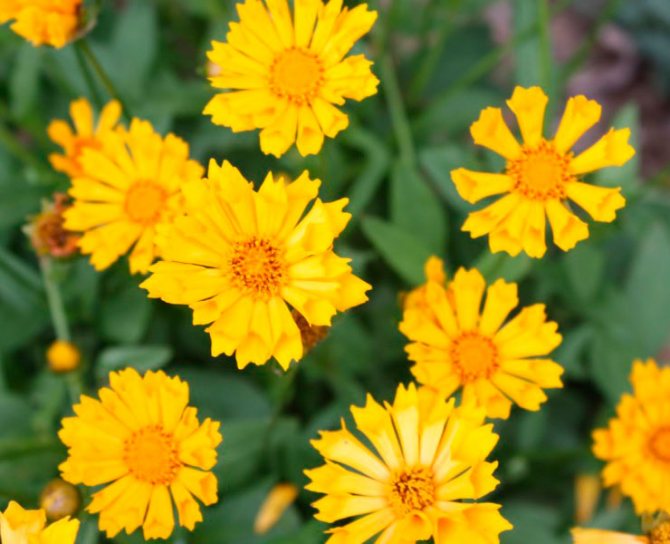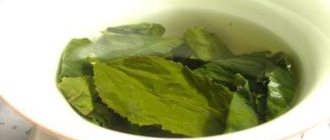general information
Coreopsis belongs to the Asteraceae or Compositae family. The natural habitat of the flower is North and South America. It is rare to find it in the Hawaiian Islands.
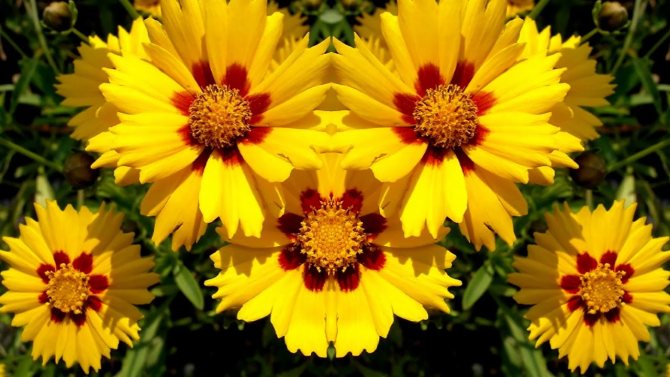
Blooming coreopsis
The plant got its name from the Greek language, where coreos means "bug" and apsis means "species". Coreopsis earned such an unusual nickname due to its seeds, which in appearance resemble bedbugs.
For reference: in Russia, the flower is called more gently - Parisian beauty, yellow daisy or Lenok.
Application in landscape design
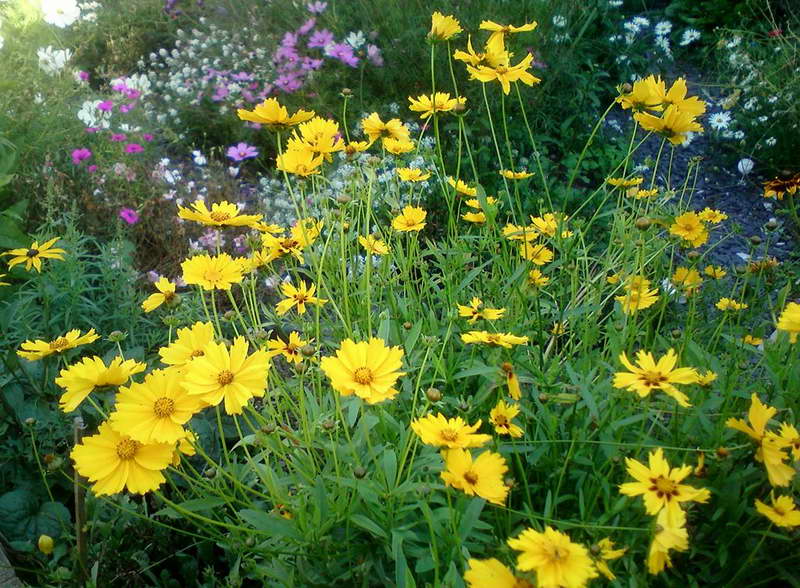

Coreopsis in landscape design photo with other colors
Tall coreopsis are good in group plantings and as a background for other plants. Frame paths, sidewalks with low-growing bushes, plant in curbs, along the perimeter of lawns, decorate terraces and balconies with potted plantings.
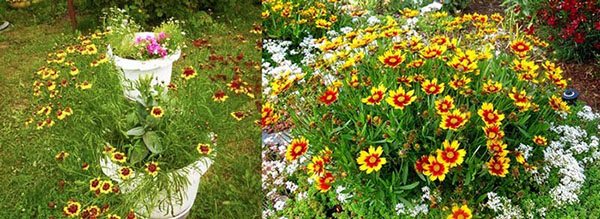

Miniature sunflower or unusual chamomile. This is how the annual coreopsis appears before amateur flower growers. From Latin, the name of the flower is translated fancifully - "the fruit of the bug." In appearance, the glossy seed pods resemble these insects.


The plant is distinguished by its extraordinary vitality. Frost and drought, wind and partial shade are transferred to them without significant losses. Gardeners fell in love with this Astrovy variety for its unpretentious care and luxurious flowering, which has fascinated the owners for almost 5 months. In June, the bush blooms, and at the first frost it drops its buds.
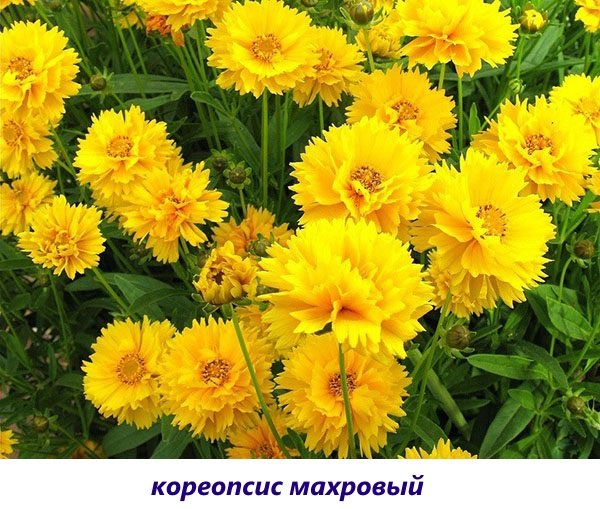

By tradition, the cultivation of coreopsis is carried out from seeds. How to plant a crop will be explained after a short description of the most popular varieties.
Light, draining and nutritious soils are suitable for annuals. When dehydrated, the plant does not die, but simply stops blooming.
Coreopsis perennial plant species
Delphinium perennial
In total, there are about 100 species of coreopsis in the world, which can be divided into two large groups: perennial and annual. Most of the representatives of this plant are herbs, but dwarf shrubs can also be found. In culture, no more than 30 species are grown.
Common types of coreopsis are presented below.
Whorled
A distinctive feature of whorled coreopsis is a wider range of colors. Inflorescences can be red, pink, orange or yellow. Reaches up to 90 cm in height. Leaves are soft green.
The plant pleases the gardener with bright flowers all summer long. The flowers themselves are small in size, the diameter usually does not exceed 3 cm. In shape, the inflorescences resemble stars. The petals are linguistic. Unlike its counterparts, whorled coreopsis grows and blooms in one place for 5-6 years.
Large-flowered (grandiflorum)
Coreopsis large-flowered is distinguished by strong branching. The plant can reach a height of 1 m. The flowers are large - 8 cm. The color range is not so diverse and there are mainly yellow inflorescences. The petals are jagged along the edges.
In one place, large-flowered coreopsis can live no more than 3 years. The flowering period is from mid-July to the first frost.
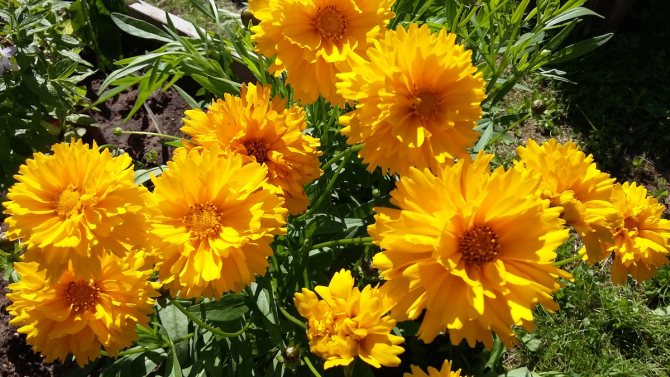

View - large-flowered
Lanceolate
The plant reaches a height of no more than 50 cm. Flowers are large enough, up to 6 cm in diameter. Multilayer inflorescences with serrated petals at the edges. The stems are covered with leaves of a bright green color.
Attention! It is recommended to transplant lanceolate coreopsis every three years.
Terry
A distinctive feature of terry coreopsis is fluffy inflorescences. This image is created by the villi that densely cover the buds.
Coreopsis flowers have a rich yellow tint, the diameter of which reaches 5 cm.The plant forms a voluminous bush, whose height is up to 70 cm.
Variegated
This variety is very abundant and blooms for a long time. The deciduous part of the bush usually does not reach a height of more than 40 cm, but the stems themselves can grow up to 80 cm.
The leaves are pale green with a white border around the edges. Single-layered inflorescences with serrated petals at the edges.
Pleases with bright colors throughout the summer.
Hybrid
A small bush up to 50 cm high. The main advantage over other species is the unpretentiousness of the plant. In one place can live up to 7 years.
Additional Information: hybrid coreopsis resistant to frost.
Flowering begins in mid-summer and can last until mid-October.
Tinting
Coreopsis dye is a representative of annual plants. It blooms profusely, with bright, but small buds, which are no more than 3 cm in diameter.
It blooms with the first frost.
Application in landscape design
Coreopsis is very easy to grow, and the bushes do not require too much maintenance. They bloom with beautiful flowers in warm yellow tones. The plant is ideal for planting in rural, rustic and naturalistic gardens.
They can be grown on perennial flower beds, and the bushes will be an interesting addition to summer flower arrangements.
Depending on the height of the plant, different varieties can be used as follows:
- undersized varieties (15-30 cm high) are great for rocky gardens, rock gardens, rockeries, flower beds;
- tall varieties (about 80 cm) should be planted at the back of the bed so that they do not cover smaller plants.
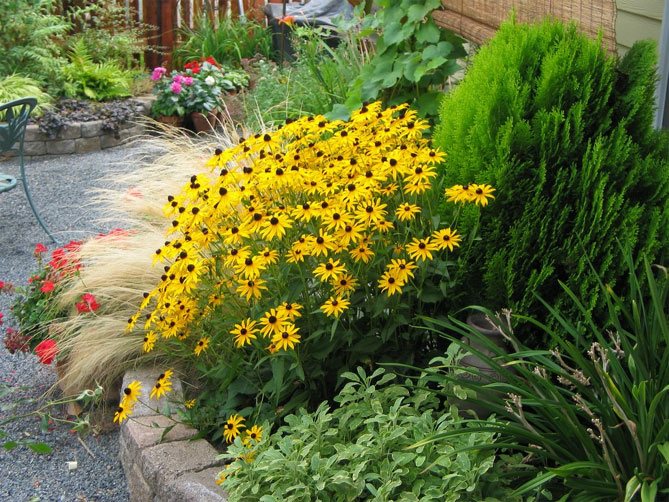

The Parisian beauty is also suitable for a cut flower. These perennials bloom all summer long, so they create an idyllic, festive atmosphere in the garden.
The most popular varieties of coreopsis
A flower that looks like a hydrangea - what is it called?
Coreopsis has long been loved by breeders for its unpretentiousness and beauty. Therefore, new varieties are bred regularly. Today, the coreopsis flower can be found in many gardens and parks.
Common varieties of coreopsis:
- Airlie Sunrise is a miniature bush covered with large, vibrant flowers. This variety is no more than 40 cm high. Inflorescences are formed already in the year of sowing. Remarkably, cut flowers can stand in water without withering for more than 13 days.
- Golden globe (Golden globe) - a small bush and reaches a height of 50 cm. The flowers are fluffy, have several shades, from pale peach to bright red.
- Sunray is an amazing variety that blooms from July to September. Flowers with petals in several layers. The sharp jagged edges of the petal and layering make it look like a fluffy, sunny ball.
- Zagreb (Zagreb) - has branched stems, up to 1 meter high. The leaves are very narrow and look more like needles. Inflorescences are star-shaped, no more than 3 cm in diameter.


Golden Globe variety
- Terry sun - the variety has such a name for a reason. Flowers, due to small, tightly adjacent petals, seem to be terry buns. The color is yellow, saturated.
- Golden baby - foliage is predominantly located at the roots. The inflorescences of the basket are densely dotted with a small bush.It blooms with bright yellow flowers from mid-summer until frost.
- Grandiflora (coreopsis grandiflora) is a neat small bush covered with yellow flowers.
- Moonbeam (moonbeam) - herbaceous perennial, with small flowers. The bushes are fluffy, with needle-shaped leaves.
How coreopsis reproduces
Shrubs with white flowers, pink, yellow flowers
Coreopsis is perennial, planting and caring for which requires a minimum of effort, can be seated in several ways, each of which has its own characteristics. Regardless of the propagation method, the plant is easily strengthened in a new place.
Important! For better survival of coreopsis during transplantation, you need loose soil filled with useful minerals.
Therefore, the soil should be fertilized in advance, a few days before planting the flower.
The main ways of reproduction of coreopsis are presented below.
- Division of the bush.
The most successful time for the reproduction of coreopsis, by dividing the bush, is the period when the air temperature warms up above 12 degrees.
Coreopsis grows rapidly, so it is recommended to divide the bush every year.
Before uprooting the plant, look at the coreopsis bush from all sides for damage. If there are no problems, the plant needs to be well watered and loosened. Then, carefully, so as not to damage the roots, get it out of the ground with a shovel.
For reproduction, 3-4 stems are taken with full-fledged roots. New shoots are transplanted into pre-prepared pits, to a depth of 20-30 cm.
Attention! After transplanting, the plant must be watered abundantly for several days.
- Growing from seeds.
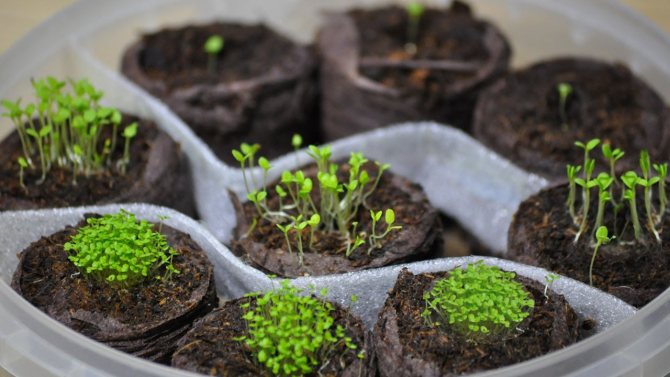

Growing by seeds
With this method of reproduction, the first flowering should be expected no earlier than a year after transplantation. To speed up this process, seeds can be initially planted and germinated at home using the seedling principle.
As soon as the flower sprouts and has 3-4 leaves, it can be transplanted into open ground. This is best done in early spring.
On a note: it is recommended to first plant coreopsis sprouted from seeds under an oilcloth. A greenhouse will make it easier for the plant to cope with temperature changes.
- Propagation by cuttings.
July is considered the ideal period for grafting. Cuttings should be cut from a healthy stem and have at least 3 internodes. The cut must be made oblique.
In order for the cuttings to root faster, they need to be looked after in a greenhouse. To do this, each shoot must be planted in a separate container, watered abundantly and covered with foil.
Rooting of cuttings is faster if kept indoors, avoiding direct sunlight.
Once the cuttings are in place, they can be transplanted outside. Greenhouse conditions are no longer required.
There is no need to prepare the soil for coreopsis. It is enough to mix the soil with compost from the leaves.
Reproduction by dividing the bush
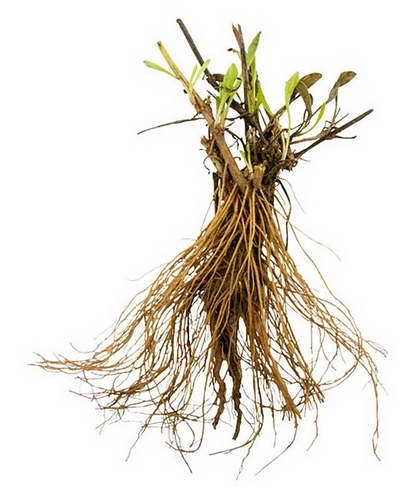

How to split a coreopsis bush photo
Perennial plants can be propagated vegetatively (bush division, cuttings).
- The division of the bush is carried out in the 4th year of growth in spring (in regions with a cold climate) or in autumn in areas with warm winters.
- Carefully dig out the bush, divide it into parts, each of which should contain a rhizome and 2-3 growth buds, and plant it.
Features of caring for coreopsis in the garden
Despite the unpretentiousness of coreopsis in care, due attention should be paid to the flower.
It is enough to follow a few rules:
- Watering. Abundant watering is required only during the breeding and rooting period in the open field. Then the flower has enough natural moisture from periodic rains.
- Spraying on a regular basis is not required. Sometimes it is enough to knock the dust off the plant by gently pouring it from above through a watering can. The water pressure should be moderate so as not to knock off the inflorescences.
- Humidity.The flower is resistant to drought, and excessive moisture can cause the death of the flower.
- Top dressing. Fertilizers are best used when coreopsis is just taking root. The plant is very sensitive to fertilization, which can lead to overgrowth of the leafy part. Therefore, it is sufficient to use organic mixtures at the end of the season. If the feeding is from the store, you need to study the description of the composition in detail.
When and how coreopsis blooms
Almost all types of coreopsis bloom at the same time - this is the period from mid-summer to mid-October. The most abundant flowering occurs at the end of August. By this time, the plant forms the maximum number of inflorescences that replace each other.
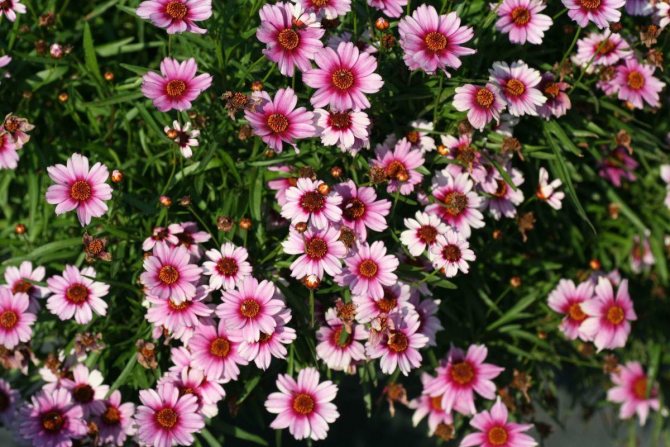

Perennial coreopsis flowering
On a note: for the plant to bloom better, it is necessary to periodically remove the sluggish leaves.
This procedure promotes the formation of new buds, which means that the plant will delight its owner with abundant flowering longer.
One of the important advantages of perennial coreopsis is that during the flowering period, the basics of plant care do not change in any way. You just need to make sure that the inflorescences do not outweigh and do not break the stems. For this, props can be arranged.
Care


In order for coreopsis to develop normally, drive out new shoots and buds, it needs to be fed three times a summer. It is better to use potassium-phosphorus mineral fertilizers, since with an excess of nitrogen, the plant begins to grow leaves, forgetting to set flowers. The result is an abundant green mass. It is impossible to use the seeds of overfed plants for further reproduction - with an excess of fertilizers, the genetic code changes and decorative qualities disappear. Such plants are destroyed.
Important! To determine whether to feed the flowers or not, you need to wait for flowering. If each plant has buds, then there are enough nutrients in the soil.
Watering is carried out in hot weather, preventing the soil from drying out too much, otherwise flowering stops. Use soft warm water. The procedure is performed in the morning or in the evening when sun activity decreases.
The garter is necessary for single-planted tall species of coreopsis, which tilt under the weight of the peduncles. The best option is to plant a plantation of plants so that they support each other.
Transplant after purchase and during reproduction
Coreopsis can be planted outdoors in both spring and autumn. If a new inhabitant of the garden appeared before winter, then the landing should be carried out under the snow. The plant tolerates frost easily.
On a note: only well-rooted flowers that have at least 4 strong leaves can be planted under the snow.
You can additionally insulate the young coreopsis by covering it with a thick cloth for the period of cold weather.
A plant bought in spring does not need additional insulation and is ready for planting in open ground immediately after purchase.
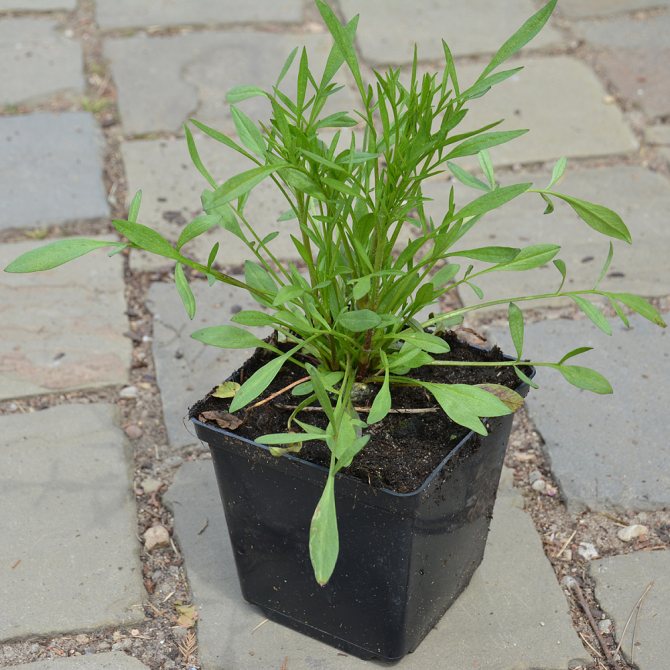

Flower transplant
Breeding methods, planting
Coreopsis are rather short-lived perennials, so it is worth updating the plantings every 3-4 years.
They reproduce in 3 ways:
- seeds;
- dividing the bush;
- reproduction of coreopsis by cuttings.
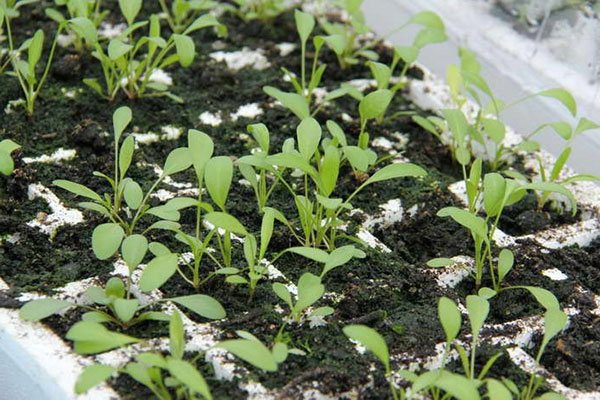

When coreopsis multiplies by dividing the bush, the plant is dug out immediately after flowering, the rhizome is divided into several parts with a knife and immediately planted in the ground.
You can start growing coreopsis by sowing seeds and preparing seedlings yourself. When propagating from seeds, it is advisable to purchase them in specialized garden centers. You can sow in spring or autumn (then they need to overwinter). When to plant seeds for seedlings depends on whether we can provide plants with a decent winter.
The choice of containers for sowing seeds:
- small pots with a diameter of 9-10 cm, in which the bushes are grown alone;
- large pots with a diameter of 13-15 cm, which can accommodate 3 plants.
For cultivation in a pot, a permeable substrate with a pH of 5.8-6.4, containing peat and clay, is chosen.
At the end of spring, one-year seedlings grown in pots from seeds or cuttings obtained from the mother plant are transplanted into the soil. Seedlings are planted in open ground when the threat of late spring frosts passes, usually in the second half of May, in regions with a colder and more severe climate, in late summer - planting is carried out in late May-early June.
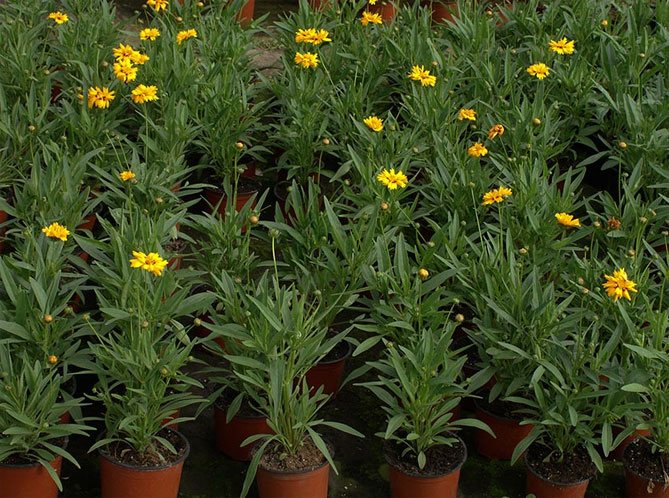

In the open field, cultivation from seeds is also possible in warm regions and the middle lane. Seeds are sown in the second decade of May. Flowering when sown outdoors will start later than when grown from seedlings.
Possible problems in growing coreopsis
Like any plant, the darling of the sun - coreopsis, can hurt. Signs of improper care and how to remedy the situation:
- Fungal disease - rust, in which dirty yellow spots appear on the leaves. You can cope with the problem by treating the flower with a special solution and removing damaged leaves.
- Fungal disease - spotting, refers to viral diseases and is not cured. Moreover, if dry spots are found on the leaves and stem of a plant, it must be uprooted and burned. The flowerbed should be treated with special preparations.
- Aphids are easy to remove. A few insecticide treatments are enough.
It is necessary to monitor the state of coreopsis regularly: remove buds that have faded and weak leaves, cut out wilted stems.
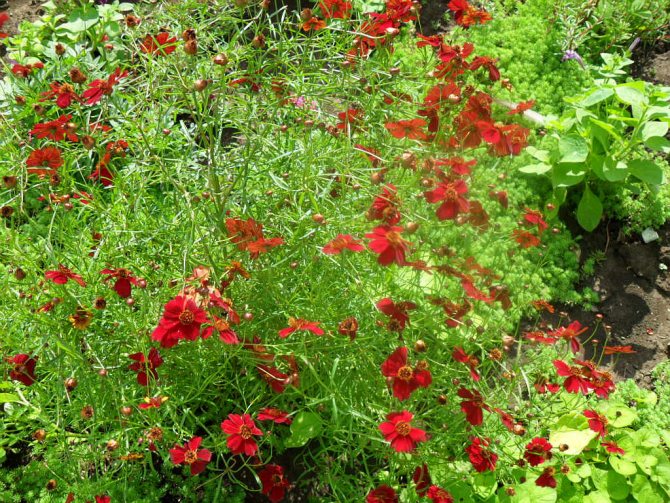

Coreopsis in the garden
It is a pleasure to grow perennial coreopsis. The minimum of requirements for care, but the gratitude of the plant, in the form of rapid flowering for a long time, is amazing. Cut flowers will be a great decoration for your home and will cheer you up on the most cloudy day.
Diseases and pests
Coreopsis has a fairly strong immunity and is rarely attacked by pests or diseases, however, there is no one hundred percent guarantee. Known diseases include leaf rust and fusarium. In this case, it is enough to tear off the damaged leaves, you can spray the plant with fungicides. If these funds do not help, then the bush should be completely removed to prevent infection of other plants in the flower garden.
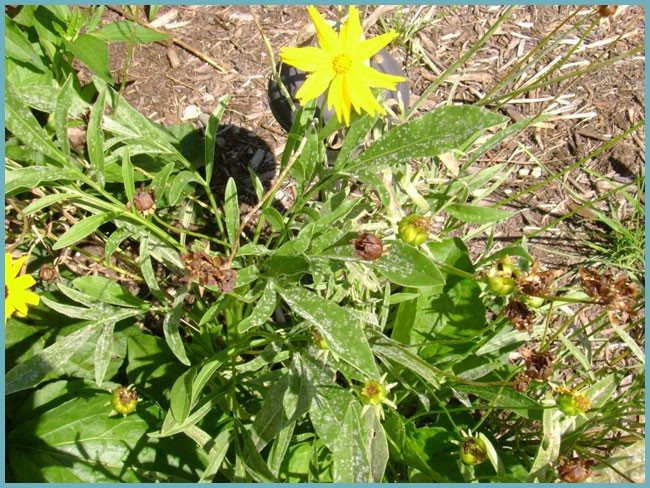

More often than other diseases, coreopsis is overcome by fusarium
The same should be done when viral infections are detected. If the plant has stalled in growth, its tops and flowers roll up into a tube - feel free to remove the bush.
Of the pests, coreopsis can infect aphids and various beetles. Beetles must be removed by hand, while specialized preparations or folk remedies can be used for aphids.



